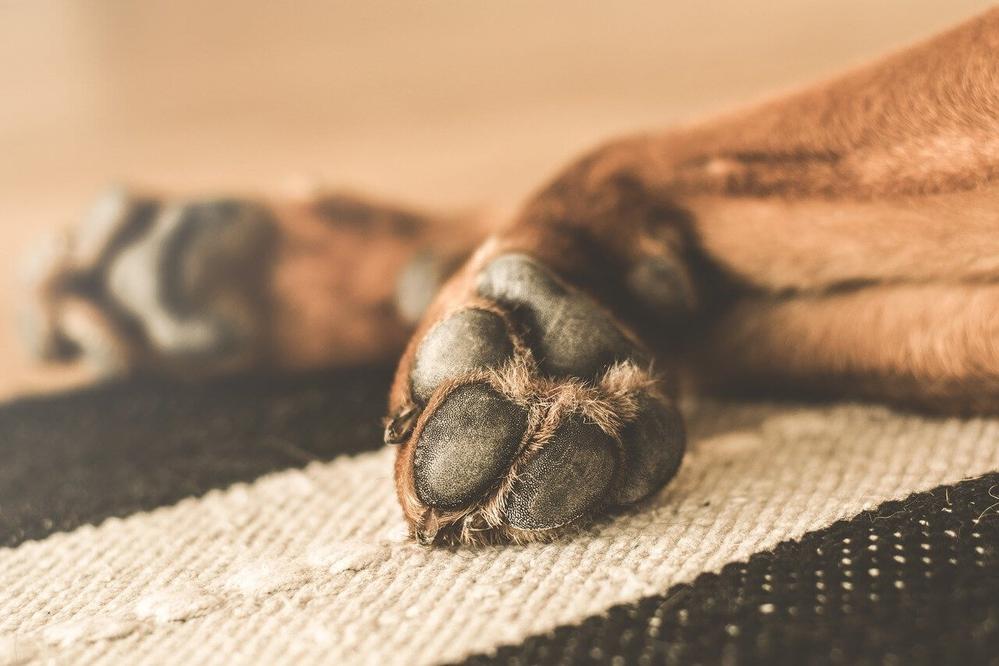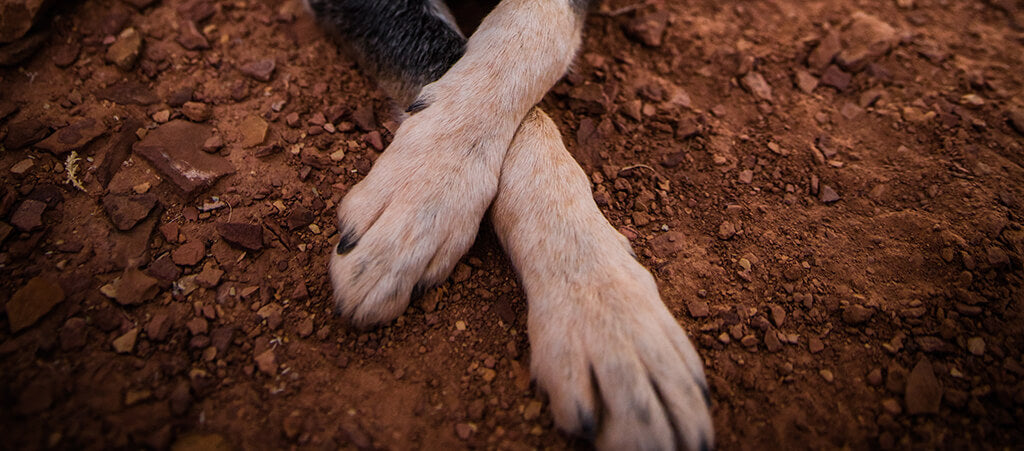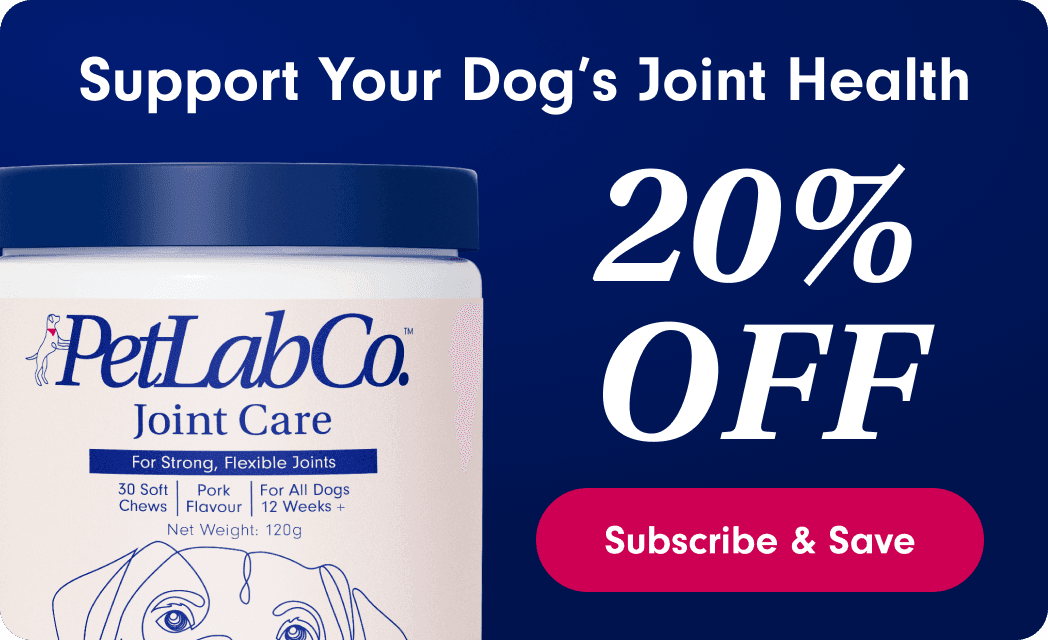
Dog Paw Pads: 8 Common Paw Health Issues
Estimated Read Time: 6 minutes
Summary: In this blog, learn all about dog paws and how to properly care for them. Learn the most common dog paw health issues from cracked dog paws and the signs of infection to what it means if your dog licks their paws a lot. And, most importantly, how to help rectify any poorly paw...
Unless your pup wears doggy socks all day long, your pooch will spend most of their time walking around on their paws – their very own built-in shoes! Each daily walkies can be spent trotting up and down the sidewalk, running around in the grass, getting the zoomies by the surf, or digging in the dirt – which can all take their toll on your pup’s paw health.
Dog Paws
Dog paws are made up of four claws – one dewclaw (the little “thumb” found on the side), four digital pads (beneath each claw), one metacarpal pad (large heart-shaped pad in the middle of the paw), and a carpal pad (hidden near the ankle joint) – all serving different functions for your pup;
- Digital and Metacarpal pads; protect the bones and joints in the foot by acting as shock absorbers.
- Carpal pads; act as ‘brakes’ to help your pooch move easily on slippery or steep slopes/gradients.
Each squishy pink or black toe bean has a thick layer of fatty tissue that is needed to insulate the inner foot, protecting it from extreme temperatures and rough ground.
Now, it may seem obvious, but did you know that when a dog is exposed to a lot of rough terrains and surfaces, the pads on their paws will have thicker and rougher skin? Likewise, when a pup stays inside, on carpets, rugs, and softer surfaces, their paws will be smoother.
Dog paws are incredibly adept at reacting to different environments and are the only area on the body where a dog can produce sweat. Just like us humans, when your pup is anxious or stressed, their paws can exude moisture and become ‘sweaty’!
Dog Paw Injuries
Due to the nature of your pup’s paws, injury is more common than you may realize, but those padded toe beans can be overlooked easily – especially when we only get to see them when our furry friends are laying down.
Knowing what to look out for will make your job as a puppy parent easier. Take a look at some of the common signs of dog paw injury;
- Licking and/or chewing their paws
- Limping
- Red, swollen, or inflamed paws
- Weeping or discharge
- Cuts, lacerations, or tears
- Dry, cracked skin
- Hair loss
- Blisters
- Torn/cracked claws
- Cysts or growths
- A foul odour coming from the paw
- Bleeding
- A reluctance to walk or put weight on their paw(s)
If you notice any of the above, please see your veterinarian, as they will be able to help you determine what the problem is because some of the same symptoms can indicate very different causes! It’s always best to get things checked by a professional when it comes to ensuring the correct care for our fur babies.
Causes of Dog Paw Injuries & Health Issues
1. Cracked Dog Paws
Your dog’s paws should have a little bit of roughness to them as this helps them get traction and grip when on different surfaces. But, cracked dog paws aren't good news.
There are some factors that can affect your pup’s pads negatively, drying them out and causing them to crack. These include hot paths/sand, chemicals, intense cold (snow and ice), dry air, extreme rough surfaces (sharp rocks/glass), and constant licking.
If you think of your own skin when it’s dry or cracked, it's painful, right? Well, your pup is the same if they develop cracked dog paws. If their pads become cracked and dry, it can make them very uncomfortable to walk on and could also even lead to infection if the wounds are not managed properly.
2. Allergies

Allergies are more common in dogs than you may realise - these include parasitic, environmental and dietary. To try and relieve the irritation, your pup will bite, chew, and lick their paws but self-inflicted skin trauma can actually make things much worse for their paw condition and provoke an infection to take place.
3. Fungal and Bacterial Infections
It is completely normal for your pooch to have different types and species of bacteria and fungi living on their paws. However, it is when the organisms grow out of control and overpopulate that can cause an infection. Bacterial, yeast, and other fungal skin infections are quite common in dogs, often affecting their ears, skin, and paws.
Typical signs and symptoms of a paw infection include; licking, chewing, pain, biting, redness, swelling, and sometimes weeping from the pads of your dog’s paws. The skin between their toes can also suffer from a greasy, oily discharge and nail discolouration if a fungal or bacterial infection has developed. Ringworm and yeast infections are common aggressors that may attack your pup’s paws.
Plus, as mentioned above, our dogs can suffer from allergies, and quite often, a yeast, fungal, or bacterial infection could be the result of allergies chronically affecting the skin. This is also true for other immune-mediated skin diseases such as symmetrical lupoid onychodystrophy and pemphigus, which affect the feet. Constant inflammatory response with continuous licking of the paws will likely lead to proliferation of microorganism and an infection in the area, which will need to be treated.
Always speak to your vet if you suspect your pup has a fungal or bacterial infection.
4. Blisters, Sores & Burns
When you’re enjoying a lovely warm sunny day, don’t you hate it when you step outside barefoot and the pavement is scorching hot? Well, here is a top tip – if the floor is too hot for your feet, it is also too hot for your dog’s paws!
Lots of pets suffer from burns on their pads if they have been walking on a surface that is too hot. You’ll know if they have burnt paws as they will look red, swollen, and sometimes blistered from the excessive heat – just like how our skin reacts to sunburn or if you catch yourself on the oven!
Burnt paws are quite serious, and should be seen by your veterinarian as soon as possible to try and soothe the vulnerable area of skin on their pads.
5. Cuts, Lacerations & Abrasions
If we walked around without any shoes on all day, we would be a lot more at risk of hurting our feet. Cuts and lacerations are common and can occur at any time when it comes to our furry friends as stones, thorns, debris, and broken glass could all be encountered on a walk. Whether they step on something whilst out on a walk or catch their paws during playtime with another dog, it is very important to keep an eye on where your dog is walking or playing.
6. Abnormal Growths
Sometimes, abnormal growths, such as cysts or lumps can appear on paws or often in-between the toe beans. Seek support from your veterinarian if you notice any new lumps or bumps on your pup's feet and get a check-up, so they can treat and/or remove the growth if possible or necessary.
7. Parasites
Hair loss, scaling or swollen dog paws can be signs of parasites. Ticks, fleas, mites, and other tiny microscopic parasites are known for hiding between dog toes, causing all sorts of health problems. These little irritants can leave your pup in a lot of pain, or suffering from an infection if left untreated.
8. Grass seeds
If your dog has a red, swollen foot and is constantly licking the area, this may indicate they have a foreign object such as a grass seed that has penetrated through the foot! Grass seeds are notorious for getting into places they shouldn’t, and are a very common problem especially in the summer months. They are most commonly seen to get trapped inside the ear, the eye, in between the toes and in the skin.
Because of their one directional dart-like shape they are sharp enough to penetrate the skin or a crevice, but they cannot come out themselves and instead keep migrating forwards - some even end up as far away as the lungs! This can cause swelling, abscesses and infections if not found and removed early.
It is important to go to the vet so they can scan the paws to see that there isn’t a pesky grass seed stuck inside. They’ll often need to be removed by the vet, as well as giving your pup the necessary medication to reduce swelling and clear the infection. Make sure you don’t ignore the signs because grass seeds can become very painful for your pup, and may damage a completely different area of the body if not removed promptly!
PETLAB CO.'S IN-HOUSE PET CONSULTANT NICOLE'S INSIDE KNOWLEDGE!
"Interdigital pyoderma (i.e. infection between the toes) is often not a specific condition since many underlying diseases can cause this. In general, causes can include underlying allergies leading to trauma, foreign bodies, parasites and parasitic allergies, irritant chemicals, immune-mediated disease and endocrine disorders - so it’s important to understand which of these is creating the recurring problem.
Please also remember that if your dog always has wet paws from over-enthusiastic licking, it predisposes the area to secondary infections. Bacteria thrive in warm, humid environments so it’s important to prevent your dog licking as much as possible. Keeping the area dry and cleaning it with dog-friendly antiseptic would be beneficial. Daily epsom salt paw soaks can help ease some of the inflammation too!"
Cracked Dog Paws Prevention & Care

Although most of the above require medical and professional assistance, there are some things you can do yourself to help protect your dog’s paw health...
Watch The Weather
During the summer and warmer months, it is so important to avoid walking your dog during peak times (10am-4pm) when it's at the highest temperatures. Not only because of dehydration but also because of their paws, as paths and sand (if you live on the coast) will be extremely hot and could blister and burn your pup’s paw pads.
Likewise, winter can bring its own dangers for your dog’s paw health. Chemical ice melts and rock salts to help vehicles and pedestrians during heavy snow and icy conditions can stick to your dog’s paws, which can cause irritation and potentially lead to your pooch ingesting them during grooming – this is extremely dangerous. Make sure you wash your pup’s paws after walks with warm water to rinse away the harmful salts and chemicals.
Dog Paw Balm
Using a specifically formulated paw balm can give loving pet parent's that extra confidence every paw parent needs when taking their dog out – particularly those that have sensitive, dry, vulnerable but adventurous paws. After and before walks on hard or uneven terrain and during the colder months, a dog paw balm can be great for protecting and nourishing your doggy's pads.
Make sure to source a dog paw balm that contains nourishing oils and waxes and one that promises to provide a moisturising seal which can promote long-term paw health.
Parasite Prevention
Flea and tick control is essential for all dogs and can prevent them experiencing unnecessary discomfort and irritation. Regular flea and worm prevention control protects both your dog and others they come into contact with from contracting pesky parasites that can hurt their skin and paws.
Regular Paw Health Checks
A great and effective way to care for your dog’s paws and prevent injury and health issues is to keep up with constant and regular health checks. Give those squishy toes and pads a check after they've been playing outside, have been for a walk, or anything where an injury to their paws could take place. If you notice any cuts or anything stuck in their paw, act quickly to try and prevent more sinister and serious health problems developing.
Doggy Pedicure
Keeping on top of your pup’s nails can do wonders for their paw health too. Dog nails should be trimmed if they grow too long, however, some dog breeds don’t require their nails to be trimmed as often as others!
Now, some dogs can find nail trimming very distressing, so it is wise that you find ways to make this part of essential care as calm and stress-free as possible. If you’re unsure, it is wise to ask a professional grooming service to clip your pup’s claws, as they will know how short to cut and will also be on the look out for any health issues that you'll need to know about.
Dog Paws
Keeping an eye on dog paws and their health is a key part of being a pet parent. With so many different causes of paw problems, knowing the signs and symptoms can help you react in the right way and take action if needed. As long as you keep their pads clean and clear, with regular health checks, you should be able to help your pooch live a paw-problem-free life!







